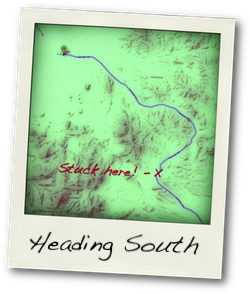
(Continued from: Down at the Depot - Cima Sub Shots - Part 2)
Eventually my frozen fingers thawed and I proceeded along my route towards Ivanpah, CA. I would have to go through Cima, CA in the process and I thought perhaps I should stop for the night and tackle Ivanpah in the morning with fresh light and fresh legs.
As I reached Cima it was pitch black. The moon had yet to rise and it was dark, really dark. As anyone who has tried to navigate an unfamiliar trail in total darkness will tell you, it was challenging. I tried to navigate, best I could, with a TomTom GPS unit that reflected roads, or what it thought were roads, that simply were not there, or no longer there. I looked for a safe spot to camp that wasn’t going to put me on someone’s private property. I did eventually find a trail that looked promising so I swung my camper onto it and crossed the tracks near Cima Hill. After a decent effort I concluded that my efforts would be in vane because the area presented too much risk for little reward and I found a wide spot to turn around and backtrack to the sanctuary of the paved roads. I opted to press on to Ivanpah. Perhaps it offered a better option, I foolishly thought.
I had originally hoped to traverse the distance between Cima and Ivanpah by going along the tracks on a dirt road shown on the park map, but it looked as though it really was a railroad access road and thought it best to not try it out, especially alone at night. I stuck to the asphalt and garnered a plan. I decided to just play things as they were dealt.
I reached Ivanpah in relative short order considering the amount of time it might had taken me had I plied the dirt trail rather than the road. I reached the tracks and slowly crossed them. As I did I glanced both ways and looked for any indications of train traffic. Bingo! I spied a headlight off in the distance coming from the east. I parked on the shoulder and gathered my gear.
 The cold was now enveloping me once again as I walked to the crossing and surveyed my surroundings. Fortunately, there was a single bulb burning on the outside of a railroad signal shed at the crossing that afforded me enough ambient light to get a general sense of my surroundings.
The cold was now enveloping me once again as I walked to the crossing and surveyed my surroundings. Fortunately, there was a single bulb burning on the outside of a railroad signal shed at the crossing that afforded me enough ambient light to get a general sense of my surroundings.
Perhaps I misgauged the distance of the train or I had taken too long to get my gear together and set it up but the train had now activated the crossing lights and bell. I fumbled with levelling my tripod and tweaking my settings on the camera. I didn’t have enough time. I fired off a few shots in hopes of something going right but post-processing would prove that this effort was futile. All I got was the bright glaring gleam from the train’s headlights and ditch lights with no other relevant details. Bummer.
 I often wonder what the train crews must think when they see someone like me, out there, literally in the middle of nowhere, in the dark, freezing my ass off, trying to get a picture of a stupid train. They probably think “stupid foamer.” I might. But they would be wrong. I am committed compelled to capturing all aspects of railroading in America in all conditions. To me, nothing says “American Railroads” like a slow drag freight or a hot intermodal cruising through dark and desolate landscape of the Mojave Desert with two guys (or gals) moving all of that freight easily and effortlessly, and moving America forward at the same time, as they have for the last 140+ years. So I am there. I am there because you can’t be — or, perhaps more accurately, you don’t want to be! (“You want me on that wall. You NEED me on that wall!” But I digress…)
I often wonder what the train crews must think when they see someone like me, out there, literally in the middle of nowhere, in the dark, freezing my ass off, trying to get a picture of a stupid train. They probably think “stupid foamer.” I might. But they would be wrong. I am committed compelled to capturing all aspects of railroading in America in all conditions. To me, nothing says “American Railroads” like a slow drag freight or a hot intermodal cruising through dark and desolate landscape of the Mojave Desert with two guys (or gals) moving all of that freight easily and effortlessly, and moving America forward at the same time, as they have for the last 140+ years. So I am there. I am there because you can’t be — or, perhaps more accurately, you don’t want to be! (“You want me on that wall. You NEED me on that wall!” But I digress…)
At this point I began to question my own sanity. My fingers became so cold that I couldn’t properly operate the controls on the camera and the gloves I had, while providing relief from the cold, were like wearing oven mitts. Perhaps I should call it a night. I didn’t want to head home because I still had the next day, President’s Day, off from work and I was already here so I convinced myself that I should try one of few traditional campsites located in the preserve.
My target was the “Hole-in-the-Wall” campground. I reasoned that it was located between the Cima Subdivision and the BNSF’s Needles Subdivision, my home turf, so I could go either direction in the morning. I was familiar with the south side of the route, Lanfair Road but I had never crossed the New York Mountains from Ivanpah Road to Lanfair Road. I knew that the pavement would end a few miles from my starting point but I felt confident that I could make it. I set out.
 In a “Donner ‘esque” kind of moment I jumped at the brief opportunity presented by a cellular signal and phoned home. I apprised Deb of my intentions and fully described the route I was taking - just in case. Good thing I did.
In a “Donner ‘esque” kind of moment I jumped at the brief opportunity presented by a cellular signal and phoned home. I apprised Deb of my intentions and fully described the route I was taking - just in case. Good thing I did.
The road changed from the asphalt to one of graded gravel/dirt and, even though I missed the train at the crossing, I was living large. I had the shots from Kelso and you know I was “doing my thing,” the way I chose to - for better or worse. I cranked up the heater to compensate for the fact I had opened the window to have a smoke and enjoy the brisk night air. I clicked the “Shuffle” button on my iPhone and it began blaring Queen’s Bohemian Rhapsody and I sang along as loud as I could. No doubt with perfect tone and pitch and on key. Again, I was living large.
I motored on, clearly climbing a grade at this point, and I caught glimpses of a large drop-off on the left side of the road. I hugged the right side of the road from that point forward. “Boy that would suck,” I thought. Realizing I now had no cellular signal, I began to console myself with the fact that, despite the below freezing temperature, I at least had a warm shelter, plenty of water and propane - should anything bad happen.
And then it happened…